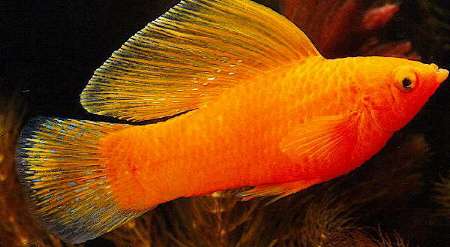Molly - Marble Sailfin
Black Sailfin Molly, Marble Sail Fin Molly Scientific Name: Poecilia velifera
Fri, 18th April, 2025 - 8:24 pm GMT
Sponsor Ads:

Alternative Name
Black Sailfin Molly, Marble Sail Fin Molly Scientific Name: Poecilia veliferaBasic Info
Sailfin Mollies have, as their name would suggest, fins that look like sails. The male's dorsal fin is large and normally lies close to the fish, though it can be extended like a sail. Female Sailfin Mollies have smaller, more rounded dorsal fins. The bodies of Sailfin Mollies are laterally compressed. The body shape is elongated, with males measuring about six inches, although females are longer. There are various varieties of Sailfin Molly available. Marble Sailfin Mollies have a silver base coloring, with black accents. This coloration is very complicated, with a variety of spots and splotches. Females tend to have less brilliant coloring than males do. The standard coloration has bluish-green sides, speckled with pale blue or silver. The undersides of the Sailfin Molly are also blue or green, though they may be orange. Orange or blue banding is also present among the dots on the sides of the Molly, and continues
Health
Sailfin Mollies normally do best when kept in large aquariums and some are bred in outdoor ponds. Usually, Sailfin Mollies do well in temperatures between 75 and 82 degrees Fahrenheit. A pH between 7.5 and 8.2 is preferred. A small amount of salinity in the water is often quite healthy for Sailfin Mollies. Usually one teaspoon for every two gallons of water is used. Sailfin Mollies usually do well when kept alone, though they can also do well in groups of similar fish. Many Sailfin Mollies can do well when maintained on flake or formulated food, though fresh vegetable matter like spinach, peas, zucchini, or boiled lettuce is also important. It is helpful to leave algae in the Sailfin Molly's aquarium, since this is an important part of their diets. Frozen plankton, daphnia, and vegetable diet can also be offered. Occasionally, live or frozen bloodworms, glass worms, or brine shrimp can be offered, in addition to live tubifex worms or frozen beef heart. Breeding Male Sailfin Mollies can be distinguished from females by the presence of a gonopodium, or breeding organ. These are believed to develop out of the anal fin as the male matures. Sailfin Mollies are often best bred in large aquariums or ponds. Though it has been recommended that female Sailfin Mollies should give birth in a separate tank with plenty of vegetation if they are to be bred in aquariums. Some female Sailfin Mollies may show their pregnancy as a dark mass in their stomachs. They usually bear a large number of young. Sailfin Mollies may eat their young. The young fish usually accept fine flake food.Habitat
Fresh water fishBehavior
The beautiful Sailfin Molly has a truly unique appearance. Although males may be a bit showier than females, all Sailfin Mollies can make lovely and interesting pets. Although Sailfin Mollies can do well in community environments with similar fish, they can also be kept alone. In fact, they may be best kept alone. When kept in groups, normally two females per male is a good ratio. Sailfin Mollies should be kept in open spaces with live plants for hiding places. up to the caudal fin. Orange, black, or brown edges accent the dorsal and caudal fins and are often marked with pearly speckles.Origin
Central AmericaHistory
Sailfin Mollies are also known as Mexican Sailfin Mollies. They are usually found in coastal waters in Mexico's Yucatan Peninsula.Common Foods
N/ASponsor Ads:
"I bear a charmed life". Macbeth Act V, Sc. VIII, William Shakespeare
Molly - Marble Sailfin
Coded by: BGID® | ALL RIGHTS RESERVED Copyright © 2000-2025
Disclaimer | Privacy | Report Errors / Contact | Credits


 President of the United States of America - Real Estate mogul, Pageant owner and now one of the most controversial men in political history.
President of the United States of America - Real Estate mogul, Pageant owner and now one of the most controversial men in political history.  Politician, US Vice President and President of the USA - Joseph Robinette Biden Jr.
Politician, US Vice President and President of the USA - Joseph Robinette Biden Jr.  versus
versus  Russia: 'The Evil Empire'? Are they all that bad or is it just the USA trying to portray Russia as bad because they are a world power with land bigger and a society very different from the USA ideal?
Russia: 'The Evil Empire'? Are they all that bad or is it just the USA trying to portray Russia as bad because they are a world power with land bigger and a society very different from the USA ideal?  Global warming has been in and out as the "latest" hot topic for many years. It is, according to modern scientists, the result of man-made industrial pollutants, clearing forested areas, agriculture, etc. But now they are thinking it started way before the Industrial Revolution...
Global warming has been in and out as the "latest" hot topic for many years. It is, according to modern scientists, the result of man-made industrial pollutants, clearing forested areas, agriculture, etc. But now they are thinking it started way before the Industrial Revolution... 
 Corona virus
Corona virus 
 Users with wide screen monitors can benefit from more content on every page.
Users with wide screen monitors can benefit from more content on every page.